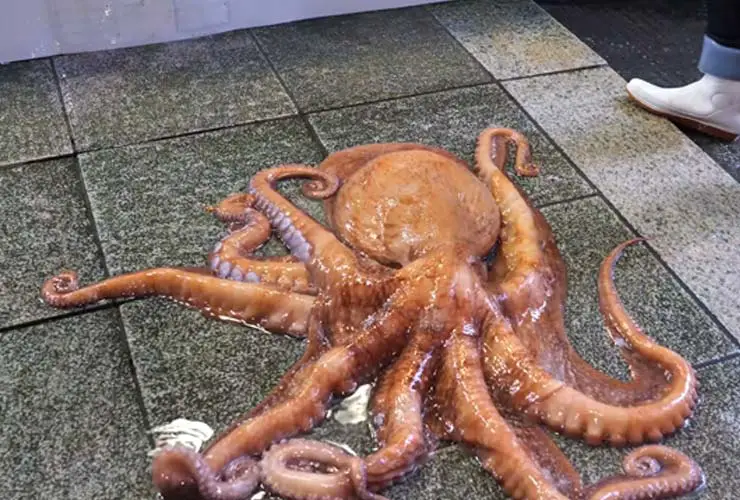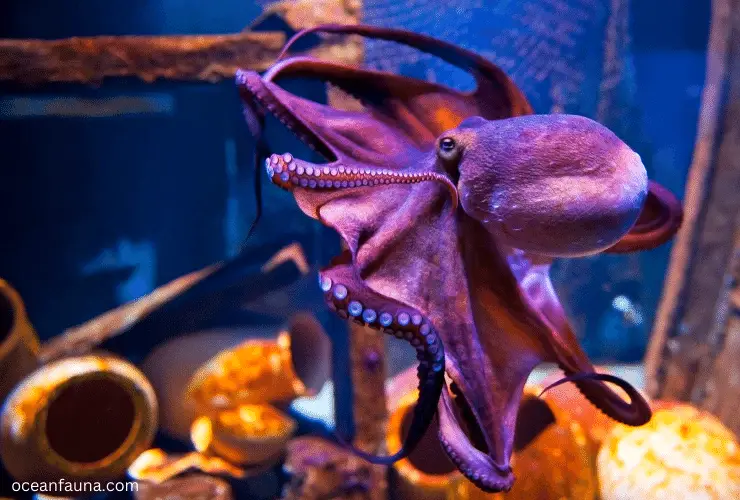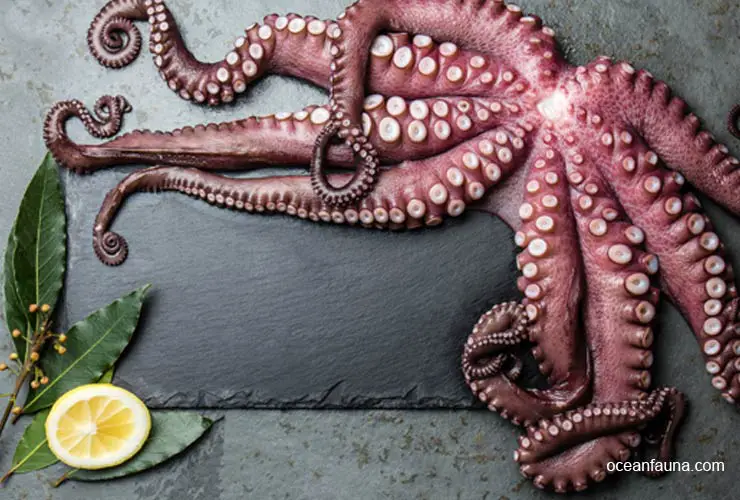Octopuses, also known as octopi, are a type of cephalopod mollusk. Nevertheless, they are known for their incredible abilities. For example, manipulate their environment, hide from predators, and escape from tight spaces.
They are also known for their remarkable ability to continue to move even after they have been cut. This process is known as the post-mortem reflex or “death throes.”
The reason octopuses are still alive after being cut is because they have a decentralized nervous system that is different from the nervous system of humans and other animals (Humans and other animals have centralized nervous systems).
This means that even if the octopus’s brain is damaged or cut, individual body parts can still move on their own.
Additionally, octopuses have a unique type of muscle tissue known as “smooth muscle” that is not under conscious control.
When an octopus’s brain is damaged or cut, its smooth muscle continues contracting and relaxing, causing body movements even after death.
This can lead to the “death throes” that people often observe, where the octopus may thrash around or even attempt to escape.
However, so far if you got curious to know more about the reasons and want to understand the logic behind it then let’s get started.
Understanding Octopus Biology

Octopuses are highly adaptable creatures with a number of unique biological features that contribute to their ability to survive after being cut.
One key factor is their decentralized nervous system. That allows them to rapidly respond to changes in their environment and coordinate their movements even if their brain is damaged.
Octopuses have two-thirds of their neurons distributed throughout their eight arms. So that it allows them to respond to stimuli and move their arms independently.
Additionally, octopuses have a highly advanced central nervous system that includes a large brain and sophisticated sensory systems.
This combination of decentralized and centralized nervous systems allows them to rapidly process information, respond to stimuli, and coordinate their movements in response to changes in their environment.
Another important factor is the octopus’ ability to regenerate limbs. The regenerated arm takes several months to grow back. But it will eventually regain its full functionality, allowing the octopus to continue living and thriving.
Finally, the octopus’ self-defence mechanisms also play an important role in its ability to survive after being cut.
These mechanisms include camouflage, ink clouds, arm autotomy, jet propulsion, and toxic secretions. All of these help the octopus to avoid danger and increase its chances of survival.
These biological adaptations help the octopus to avoid danger, escape predators, and continue living even if it sustains significant injuries.
Now let’s understand these biological facts in detail.
Ability Of Octopus to Regenerate Limbs
The ability of an octopus to regenerate its limbs is a remarkable feature of its biology. Octopuses have a high capacity for regenerating lost tissue, which allows them to regrow lost arms. Thus, they maintain their mobility even after losing a limb.
The process of regeneration in an octopus begins at the basal disk, a specialized region at the base of each arm.
This region contains a high concentration of blastemal cells, which are capable of dividing and differentiating into new tissue.
When an arm is lost, these blastemal cells activate and begin to divide, eventually forming a blastema that will develop into a new arm.

The regenerated limb is not a perfect copy of the original. But it is functional and serves the octopus well.
The regenerated limb typically starts growing from the basal disk and grows outward, eventually reaching its full size. The process of regeneration can take anywhere from a few weeks to several months, depending on the size and location of the wound.
However, this ability to regenerate limbs is not limitless. And repeated regeneration can take a toll on the octopus’ overall health.
The regenerated limb may not be as strong or flexible as the original, and repeated regeneration can lead to a reduction in the overall size of the octopus.
In conclusion, the ability of an octopus to regenerate its limbs plays an important role in its survival after being cut.
Self-defence Mechanism
Octopuses have a number of self-defence mechanisms that help them avoid predators and escape danger. These mechanisms include:
Camouflage: Octopuses have the ability to rapidly change the color and texture of their skin to blend in with their surroundings, making them difficult for predators to detect.
Ink Clouds: Octopuses can release a cloud of dark ink that obscures their escape and confuses predators.
Arm Autotomy: Octopuses can detach, or autotomize, one or more of their arms to distract predators and make a quick escape. The detached arm continues to wriggle and distract the predator, giving the octopus time to escape.
Jet Propulsion: Octopuses can rapidly contract the muscles in their mantle, propelling themselves through the water at high speeds.
Toxic Secretions: Some species of octopus can produce toxic secretions that can deter predators or even kill them.
These self-defence mechanisms help octopuses avoid danger and increase their chances of survival.
Nervous System Responsiveness
Octopuses have a highly responsive nervous system with two-thirds of neurons distributed in their eight arms, giving them independent movement control.
They also have a sophisticated central nervous system with a big brain and advanced sensory systems.
This combination enables rapid information processing and evasive action in response to danger. These adaptations play a crucial role in their survival, even after being cut, as they can still move their remaining arms.
Role of Octopus’ Behaviour In Surviving After Cutting

The behaviour of an octopus plays a crucial role in its ability to survive after being cut. Octopuses are highly intelligent and exhibit a wide range of behaviours that are adapted to their environment and help them avoid danger.
One behaviour that plays a key role in the octopus’ survival after being cut is autotomy, the ability to detach one or more of its arms. This behaviour can be used to distract predators and make a quick escape.
The detached arm wriggles and distracts the predator, giving the octopus time to escape. This behaviour is an important part of the octopus’ survival strategy and helps it to survive after being cut.
In addition to autotomy, the octopus’ ability to rapidly change the color and texture of its skin also contributes to its survival after being cut.
Octopuses use camouflage to blend in and avoid predators and can also signal aggression or mislead predators for defence and increased survival.
Finally, the octopus’ ability to rapidly escape using jet propulsion also contributes to its survival after being cut.
By quickly contracting the muscles in its mantle, the octopus can rapidly propel itself through the water, making it difficult for predators to catch.
In conclusion, the behaviour of an octopus plays a crucial role in its ability to survive after being cut. Autotomy, camouflage, and rapid escape using jet propulsion are all behaviours that help the octopus avoid danger and increase its chances of survival.
FAQs
Do octopuses feel pain when cut?
Yes, octopuses have a nervous system and are capable of feeling pain when cut or subjected to other forms of physical stress. This has been demonstrated in behavioural and physiological studies. However, the degree to which octopuses experience pain and their ability to recall it is not well understood, as they are highly intelligent and complex creatures.
Do octopuses have the ability to regenerate lost tentacles?
Octopuses have the capability of regrowing their lost arms. However, unlike starfish, a detached octopus arm will not grow into another octopus. The mysteries surrounding their regenerative abilities hold the potential to further our understanding of tissue regeneration for human diseases or loss.
Conclusion
It is important to note that post-mortem reflexes can make an octopus seem alive after it has been cut.
It is not actually alive in the sense that it cannot respond to stimuli or show any signs of consciousness. It is simply a residual physical reaction to the initial damage caused by the cutting.
In conclusion, the reason that an octopus continues to move after it has been cut is due to its decentralized nervous system, the presence of smooth muscle tissue, and the continued function of neurotransmitters even after death. These unique features of the octopus make it seem like it is still alive even when it is not.

1 thought on “Why Are Octopus Alive After Cutting?”